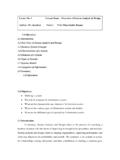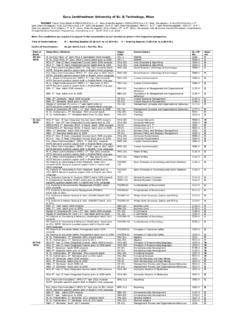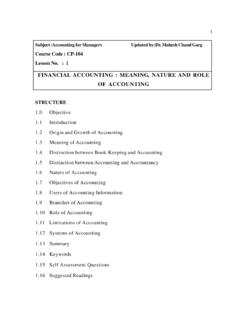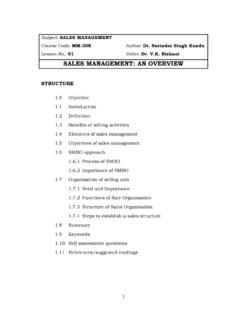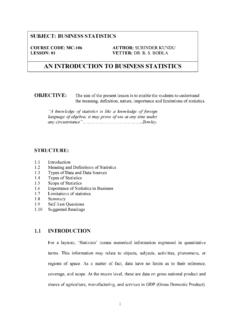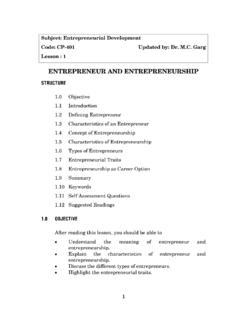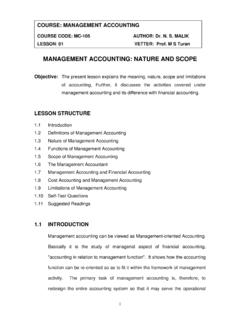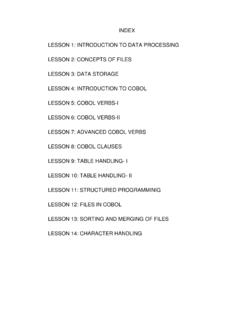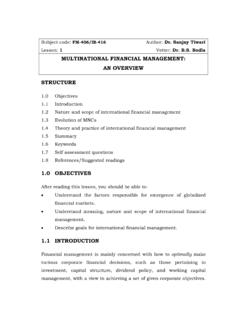Transcription of RURAL MARKETING: AN INTRODUCTION - …
1 Subject: RURAL & AGRICULTURAL marketing Course Code: MM-310 Author: Dr. Bishnoi Lesson: 1 Vetter: Dr. Atul Dhingra RURAL marketing : AN INTRODUCTION STRUCTURE Objective INTRODUCTION Meaning and definition of RURAL marketing Nature and characteristics of RURAL market Significance of the RURAL markets Factors contributing to the change in the RURAL market Green revolution Emerging Role of Bio-Tech. in Indian Agriculture Sector RURAL communication Development programmes Problems in RURAL marketing Summary Keywords Self assessment Questions References/suggested readings OBJECTIVE After reading this lesson, you will be able- To develop an insight into RURAL marketing regarding different concepts and basic practices in this area.
2 2 To discuss the challenges and opportunities in the field of RURAL marketing . INTRODUCTION marketing may aptly be described as the process of defining, anticipating and knowing customer needs, and organizing all the resources of the company to satisfy them. In fact, satisfaction of customer s needs and wants provides the rationale for the firm s existence. Knowledge of consumer behaviour, therefore, is vital for a firm to achieve its marketing goals. The consumer s behaviour comprises the acts, processes and social relationships exhibited by individuals, groups and organizations in searching, obtainment, use of, and consequent experience with products and services.
3 An understanding and knowledge of the motives underlying consumer behaviour helps a firm in seeking better and more effective ways to satisfy its customers. It helps to select appropriate sales and advertising strategies, and to plan marketing programme in a more efficient manner. The RURAL market of India started showing its potential in the 1960s. The 70s and 80s witnessed its steady development. And, there are clear indications that the 21st century is going to see its full blossoming. In our country, where research on consumer behaviour has been nominal, not much systematized information is available about the RURAL consumers.
4 Only a few enlightened companies, known for their marketing orientation, viz., Hindustan Lever, Philips India, Asian Paints, Singer and Larsen and Toubro have made concrete efforts in this direction. But, by and large, we have still to understand the RURAL buyer, 3 his habits, attitudes and behaviour, particularly from the marketing point of view. Many assumptions prevail about RURAL marketing . For instance, one assumption is that the RURAL buyer is not very discriminating. Once he is persuaded to buy a particular product, he develops a strong affinity for it, and if satisfied, becomes brand loyal.
5 As a result, Indian manufacturers are generally known to prefer selling fewer items at higher prices than selling more items at lower prices. A contrary view is that the RURAL buyer, being suspicious of the marketer s hardsell techniques, is quite discriminating, and is not easily persuaded. Yet another assumption is that the RURAL buyer is not particularly keen about quality and packaging. Some other assumptions can be quoted. But, all these need deep probing for arriving at valid and reliable conclusions. Consumer research, thus, is indispensable for entering the RURAL segment of the market.
6 MEANING AND DEFINITION OF RURAL marketing The term RURAL marketing used to be an umbrella term for the people who dealt with RURAL people in one way or other. This term got a separate meaning and importance after the economic revaluation in Indian after 1990. So, before venturing into the other aspects of RURAL marketing let us discuss the development of this area in different parts which is briefly explained here. Part I (Before 1960): RURAL marketing referred to selling of RURAL products in RURAL and urban areas and agricultural inputs in RURAL markets. It was treated as synonymous to agricultural marketing .
7 4 Agricultural produces like food grains and industrial inputs like cotton, oil seeds, sugarcane etc. occupied the central place of discussion during this period. The supply-chain activities of firms supplying agricultural inputs and of artisans in RURAL areas received secondary attention. The local marketing of products like bamboo baskets, ropes, window and door frames, small agricultural tools like ploughs by sellers like black smiths, carpenters, cobblers, and pot makers were emphasised in general. This was totally an unorganized market where all banias and mahajans (local business people) dominated this market.
8 Part II (1960 to 1990): In this era, green revolution resulted from scientific farming and transferred many of the poor villages into prosperous business centers. As a result, the demand for agricultural inputs went up especially in terms of wheats and paddies. Better irrigation facilities, soil testing, use of high yield variety seeds, fertilizers, pesticides and deployment of machinery like powder tillers, harvesters, threshers etc. changed the RURAL scenario. In this context, marketing of agricultural inputs took the importance. Two separate areas of activities had emerged- during this period marketing of agricultural inputs and the conventional Agricultural marketing .
9 During this period, the marketing of RURAL products received considerable attention in the general marketing frame work. The formation of agencies like Khadi and Village Industries Commission, Girijan Cooperative Societies APCO Fabrics, IFFCO, KRIBHCO, etc., and also the special attention government had paid to promote these products were responsible for this upsurge. Village industries flourished and products like handicrafts, handloom textiles, soaps, safety matches, crackers etc. hit the urban market on a large scale from RURAL areas. 5 Part III (After Mid 1990s): The products which were not given attention so far during the two earlier phases were that of marketing of household consumables and durables to the RURAL markets due to obvious reasons.
10 The economic conditions of the country were as such that the RURAL people were not in a position to buy these kinds of products. Secondly, our market was in a close shape and we newer allowed companies (foreign) to operate in Indian market. But we lifted the .. and opened up economy, consequently companies started flourishing in India. The small villages/hamlets were widely scattered making reach difficult and expensive consequently. RURAL markets were seen an adjunct to urban market and conveniently ignored. However, since 1990s, India s industrial sector had gained in strength and maturity.

